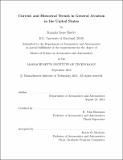| dc.contributor.advisor | R. John Hansman. | en_US |
| dc.contributor.author | Shetty, Kamala Irene | en_US |
| dc.contributor.other | Massachusetts Institute of Technology. Dept. of Aeronautics and Astronautics. | en_US |
| dc.coverage.spatial | n-us--- | en_US |
| dc.date.accessioned | 2013-02-15T14:40:10Z | |
| dc.date.available | 2013-02-15T14:40:10Z | |
| dc.date.copyright | 2012 | en_US |
| dc.date.issued | 2012 | en_US |
| dc.identifier.uri | http://hdl.handle.net/1721.1/77115 | |
| dc.description | Thesis (S.M.)--Massachusetts Institute of Technology, Dept. of Aeronautics and Astronautics, 2012. | en_US |
| dc.description | Cataloged from department-submitted PDF version of thesis. This electronic version was submitted and approved by the author's academic department as part of an electronic thesis pilot project. The certified thesis is available in the Institute Archives and Special Collections. | en_US |
| dc.description | Includes bibliographical references (p. 91-93). | en_US |
| dc.description.abstract | General aviation (GA) is an important component of aviation in the United States. In 2011, general aviation and air taxi operations represented 63% of all towered operations in the United States, while commercial aviation was responsible for 34% of those operations. It is clear that GA is a considerable component of the national airspace and airport system, even when only accounting for towered operations. Because of this significant presence, insight into GA is relevant to issues in air traffic management, air transportation infrastructure, and aviation safety, among others. Beyond the operational aspect, GA is of significance to society as a whole and to other stakeholders, including pilots groups, aircraft manufacturers, and the work force. In 2009, general aviation generated 496,000 jobs and its total economic contribution to the U.S. economy was valued at $76.5 billion. However, a comparison of general aviation's impact on jobs and on the economy between 2008 and 2009, shows a 20% decrease in jobs and a 21% decrease in total economic impact in the course of a year. There is also a significant decreasing trend in the active pilot population, along with steady decreases in GA flight hours and towered operations. The objective of this thesis is to explore the details of these changing trends and to determine what drives and what hinders general aviation activity in the country. A combination of data analysis and the development of a survey administered to general aviation pilots shed light on what has driven activity in the past on a national scale, what factors affect an individual pilot's level of activity, and what challenges the general aviation community faces in the future. | en_US |
| dc.description.statementofresponsibility | by Kamala Irene Shetty. | en_US |
| dc.format.extent | 93 p. | en_US |
| dc.language.iso | eng | en_US |
| dc.publisher | Massachusetts Institute of Technology | en_US |
| dc.rights | M.I.T. theses are protected by
copyright. They may be viewed from this source for any purpose, but
reproduction or distribution in any format is prohibited without written
permission. See provided URL for inquiries about permission. | en_US |
| dc.rights.uri | http://dspace.mit.edu/handle/1721.1/7582 | en_US |
| dc.subject | Aeronautics and Astronautics. | en_US |
| dc.title | Current and historical trends in general aviation in the United States | en_US |
| dc.type | Thesis | en_US |
| dc.description.degree | S.M. | en_US |
| dc.contributor.department | Massachusetts Institute of Technology. Department of Aeronautics and Astronautics | |
| dc.identifier.oclc | 825072093 | en_US |
